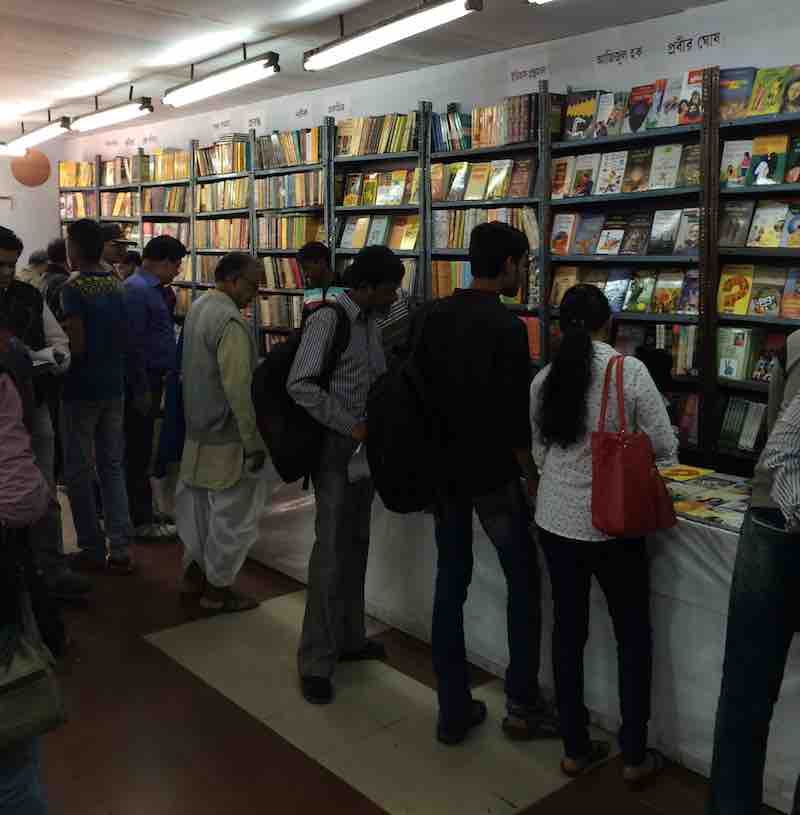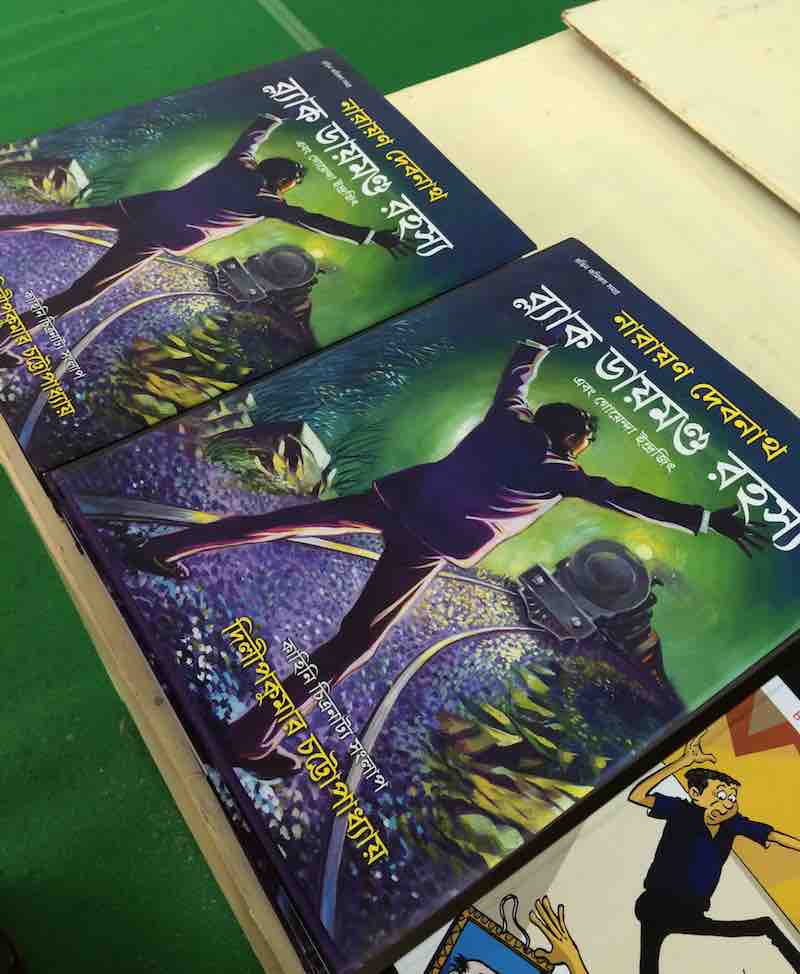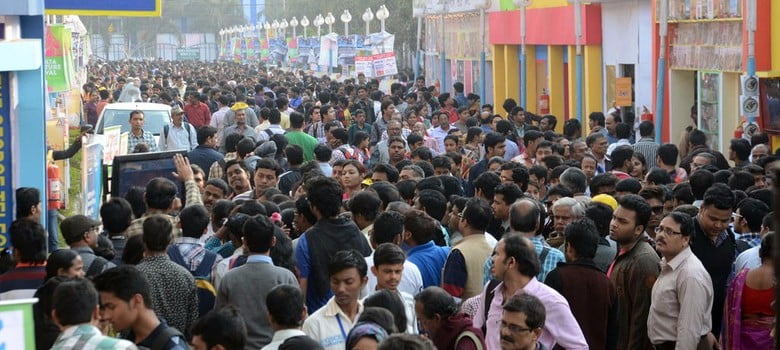
I had been warned about the dust time and again. Magazine articles, friends, all warned, bhishon dhulo (awfully dusty)! So I was prepared for the 2016 Kolkata Book Fair to be something akin to the Thar Desert. What I had not expected, however, was the music. And the public announcements. But more on that later. First, a few necessary facts about the Kolkata Book Fair, or Boi Mela, as everyone knows it.
An annual affair, the Kolkata Book Fair runs for 12 days from the end of January to the second Sunday of February. Now in its 40th year, it has seen various ups and downs, including a devastating fire (the fair was back and running in three days though one person died of a heart attack and over 100,000 books were destroyed), a major shift in venue, rains and such cataclysms. It’s one of the largest retail book fairs in the world (as opposed to trade fairs like Frankfurt and London). Such facts aside, it has remained an important part of the city’s social and cultural calendar because, well, Bengalis and books and kaalchar, and the fact that it melds “books” and “fair” spectacularly.

Ghosts of Boi Mela past
I had last been to the fair more than a decade ago, when it was still held at the Maidan – that massive patch of green in the heart of the city. From that era I held an abiding memory of long queues, where people waited patiently (maybe not so patiently sometimes) to enter the stalls of major English and Bengali publishers.
I had felt privileged and very relieved since I worked in a publishing house that was one of these hot destinations and so I could safely enter the stall as and when I pleased without a thirty-minute wait. I had even manned a few counters and convinced buyers to pick up books of my choice.
This time I was there purely as a visitor and I intended to make the best use of the one day I would get for this. That brings me back to the music. Soon after entering the Milan Mela ground, and while I was just about getting my bearings on which way to head, the Boi Mela Song started playing.
Yes, those capital letters are deliberate. It’s a song exhorting every Calcuttan worth their salt to visit the fair. The rest of the lyrics have now buried themselves somewhere in my brain under all the other noise, and all I remember is a cheerful warbling of “boi mela boi mela”. Doesn’t sound so bad, but as it accompanies you to every stall you visit, or when you sit awhile to rest the feet and tired shoulders, or when you are buying a much needed cup of tea or some ice cream, then there comes upon oneself a great desire to swat the song away like a pesky fly.
Sometimes it would stop. To be replaced by other songs – Tagore’s songs, aka Rabindrasangeet, and The Beatles – or poetry recitations. And when those stopped there would be a kindly voice telling you not to litter, that the fair had participants from all over the country and that there was a free shuttle service from Park Circus to the mela venue if you wanted it. I later noticed that this song was being played at many traffic signals too, so it basically accompanied you wherever you went in the city.
Song notwithstanding, I plunged into the maze of halls, each named after a famous litterateur and then on to the stalls which were out in the open. Discounted books, used books, brand new books, books in Hindi, they all started popping up on my path. I asked the Hindi stall person what kind of business he was hoping for. He shrugged, it was early days yet, the number of people reading in Hindi wasn’t that many, but there was enough for his company to set up shop and he hoped to do good enough business. He refused to be more specific.
I soon made my first buys at Bookline. It had books at huge discounts as well as those selling at almost the printed price. As I browsed, I heard someone yelling “Madam, madam!” I looked up to see an ex-colleague waving frantically. Cut to ten minutes of exchanging news and gossip and discussion about the state of the book industry and where does one go next in one’s career. We agreed we were going to live and die among books and in the publishing business.
With that cheerful thought, I moved on from hall to hall. Taking up a large space, Patra Bharati had a big range of books for children too. I gravitated towards those and spent time leafing through many collections of comics. There were the old Bengalu favourites like Handa Bhonda, Nante Fante (also in English, which I bought) and a detective series named Black Diamond whom I had not encountered earlier. The cover was dramatic enough with a man standing in front of an onrushing train and held much promise of action and adventure.

Brewing something else
By now the buys were enough to start weighing the shoulders down so I wandered over to the tea stall. There my friend and I were greeted with great enthusiasm by a bevy of people. They had a new variety of a paper tea cup that held the tea bag within it. You can buy one cup for twenty rupees – and get two more cups FREE using that same cup, we were informed by all those standing around and whom I had taken to be customers like us.
There was much questioning and answering on how we wanted our teas and finally with the nicely warm cups in hand we sat down to refuel for a bit. Appropriately, a stall selling jute bags had a very ugly bag with this wonderful quote from Tagore printed on it: “Come oh come, ye tea-thirsty restless ones, the kettle boils, bubbles and sings musically.”
A largish Bangladesh pavilion appeared soon in front of me. It had a number of small stalls and I could only marvel at my ignorance about Bangladeshi writing. There were some interesting and good looking books for children by contemporary writers here, including the ubiquitous Humayun Ahmed. I, however, had a fit of nostalgia and picked up a slim hardbound edition of Leo Tolstoy’s stories for children translated into Bengali with their original black and white drawings. It reminded me of the Russian books we read as children and the drawings themselves were beautiful. It cost a princely sum of seventy-five rupees.
More wandering and an ice cream later I panicked realising I was yet to visit the big stalls of Ananda Publishers, Dey’s Publishing and a few more. I hotfooted into those. Deys was already full enough to have just some elbow room. I browsed a book on Banglar Pakhi (The Birds of Bengal), recoiled at large stacks of the writings of such luminaries as Tagore and JC Bose and Upendrakishore Ray arranged into worthy topics like science and social studies. My buy here – Dadabhaier Deyala (Dadabhai’s Mischief) by Gaganendranath Tagore, and illustrated by him.
At Dey’s, while moving from one section to the next, I stopped at the section on books on cinema. Near me, stood an old gentleman in a dhoti and shawl and carrying a jhola. He waited patiently till the person at the counter was free to attend to him and asked for (what seemed to me) an obscure book on the zamindari system and land rights in Bengal. The boys needed only a few minutes to locate it (perhaps it wasn’t so obscure after all). Their buyer stood and leisurely turned the pages of the thick book for a while before telling them to bill it.

Start-ups at play
Outside, every semblance of winter had disappeared, the sun was hammering in. As I stood wondering which way to head next and tried to make sense of the Fair directory and map (the stalls don’t always follow each other numerically) I found a boy of about 10 at my side holding a sheaf of newsletters. The small publications and newsletters are all over the place, each being offered by someone with an accompanying explanation of why it was produced and by whom. I had already paid five rupees for one by a LGBT rights organisation.
This boy, part of a children’s drama troupe in north Kolkata was offering the newsletter called Boi Melar Diary that consisted of short pieces by him and his friends on their experiences at the book fair. As I stopped to talk to him, immediately 3-4 others gathered around. He handed out the newsletter to all and when one started to walk off with it, called after him saying, Eta free na! (It’s not for free!)
Priced at ten rupees each, he and a few more of his friends were selling these to raise funds for their troupe. What plays have you performed? Dakghar, Obak Jolpaan, Lokkhoner Shaktishel he reeled off a list of names. And are people buying the newsletter? Yes, he said proudly, he had sold twenty already, this was their first day and the weekend would see lots of visitors. I hoped they would cover the printing cost of the newsletter and make some more, as I bought a copy.

The smell of popcorn and the calls to come taste some chaat were building up, clashing with my old friend the boi mela song. My shoulder was telling me to call it a day, as was the call for some water and food from the stomach. I headed back to the gate making my way past the artists who had set up their tables and tarps on the ground. A man waylaid me to try out churans and to buy greeting cards from his “NGO”. What does your NGO do, I asked.Lokeder shahajjo (helping people) was the supremely vague reply.
With that ended my one day at the boi mela after a decade. I learnt later that on the Sunday of the following weekend 10 lakh people had visited the Fair. I am hundreds of miles away in another part of the country now, and I wish the many lakhs who will visit till the last day on February 7 a suitably intellectual, bodily wearying and aurally challenging time. And no, there wasn’t that much of dhulo.
[“source-scroll”]





